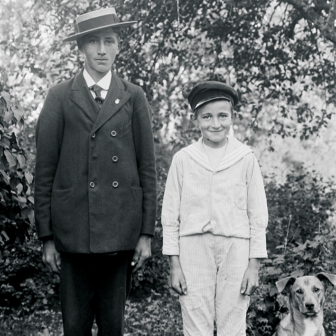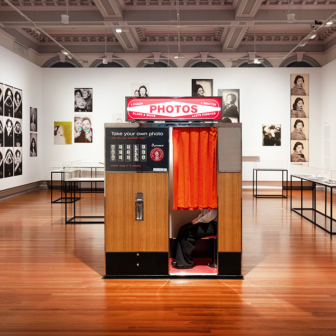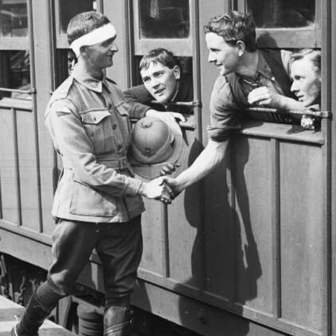Bill Henson
NGV International until 27 August 2017
Much of the National Gallery of Victoria’s hanging space is currently given over to a celebration of the art and practice of photography, the medium that has become, for very many people, the preferred mode of creativity and communication. The NGV Festival of Photography includes a display of international contemporary works from the collection alongside a number of “solo projects by Melbourne-based artists.” Taken together, they explore the extent to which the language of photography is truly international, and the extent to which it also speaks in local dialects.
Among the “special projects” is a display of images and objects by Melbourne’s Patrick Pound, an artist who anticipated the rapid rise of curatorship from a kind of backroom service for the “real” artist to an assertive act of creativity in itself. For the past twenty years, Pound has been selecting “found” photographs (“when I click BUY on eBay – for me that’s the equivalent of taking a photograph”) and grouping them thematically, reassigning value to the often anonymously created image by linking it to similar images, and thus creating a kind of order out of overwhelming abundance. At the other end of the spectrum is a display, originated by London’s National Portrait Gallery, of one hundred works by the great American photographer William Eggleston. By means of his distinctive use of colour, Eggleston creates images of people and objects that in their combination of informality and eerie formality seem to exist in perfect isolation.
And somewhere between these two poles – Patrick Pound’s emphasis on the role of selection and context; the unrepeatability of Eggleston’s singular photographs (their Eggleston-ness, in fact) – is a display of works from 2008 to 2012 by Bill Henson. Here, the man with a claim to be Australia’s best-known and most immediately recognisable living photographer very much catches the cultural moment, assuming the roles not only of creator but also of curator of his own works.
As curator, Henson presents each image as individually striking and “stand-alone,” while at the same time encouraging the viewer to see them as commenting on and illuminating one another in a complex dialogue. Large and imposing, the pictures announce themselves as meticulously composed and hard-won.
“I am not one of those photographers who wanders around waiting for something to catch their eye,” says Henson in an interview included in the latest issue of the NGV’s Gallery magazine. He favours deliberateness over spontaneity, creating the photographic moment rather than waiting for the right photographic moment to come along. Like a number of contemporary photographers, he compensates for the sheer ease of modern photography by replicating what was once an essential part of the process, namely immense time and effort invested in pre- and post-production.
These images, drawn from a gift to the gallery by William Bowness and chosen by Henson to represent his recent work, range from portraits and nudes to highly patterned landscapes and studies of museum interiors. The museum photographs, in which blurred gallery visitors (Henson is a master of the blur) circle and observe and sometimes just walk past items of classical statuary, are in a sense the core of the exhibition, establishing a relationship between viewer and object that leads us, as gallery visitors ourselves, to consider our own relationship to the images on display.
The statues that Henson chooses to photograph – the much-imitated and immediately recognisable sculpture known as the Spinario, for example, which depicts a boy pulling a thorn from his foot – are themselves formal representations of informality and naturalness, a relationship that Henson echoes by playing on the contrast between the seriousness and formality of the museum environment and the striped polos and comfortable-looking cardigans worn by the museum visitors. The museum references extend further, to the portraits and studies of the human figure that are included here, in which the unclothed models have been directed to adopt classical or quasi-classical poses.
For many people, both admirers and detractors, these studies of youthful models are the essence of Henson’s reputation and standing. But the current display provides an opportunity to see the latest iterations of the human figure in the context of the artist’s other preoccupations: our relationship to landscape and to art, the role of light and shade in defining the subject, and the interplay of modernity and history. For all their classical allusions and formal placements, these are also very contemporary photographs. An image of a young woman with her hair trailing across her face, for example, speaks several languages at once, including those of advertising and fashion.
The most successful of the studies of the human figure shows a boy in the Spinario pose, examining his foot as if for a thorn. Of all the “posed” images, it is the most directly classical in its references, and at the same time the one that seems most human and natural and, on the part of the model, unselfconsciously engaged. It is a photograph in which the composition dominates, inviting admiration for the skill involved in achieving perfect balance. In a masterful touch, Henson captures a small oblong of light on the boy’s hair, positioning it with classical appropriateness at the golden mean.
In the exhibition catalogue, splendidly produced by the NGV, Michael Heyward provides a short, impressionistic commentary, in which he notes of the studies of the human figure that “the body in the photograph becomes the sculpture it resembles.” Yet it might equally be said that the real source of the photographs’ impact is the failure of these young models to entirely become those sculptures, and the way that their modernity shines through the formality of the pose.
Just as he does in his museum interiors and landscapes, Henson in his portraits and his studies of the human figure exploits the contrast between formality and informality, the posed and the natural, to show how they interact and complement one another. Into this visually serious space he can, very occasionally, inject a joke. In one of his museum shots – titled, like all the others, “Untitled,” which serves to emphasise the interconnectedness of the images – a visitor’s floppy sunhat in the upper right of the frame echoes a sculpted helmet in the upper left, as if to draw an affectionate connection between life and art. It is the same connection that animates all Henson’s work. •




